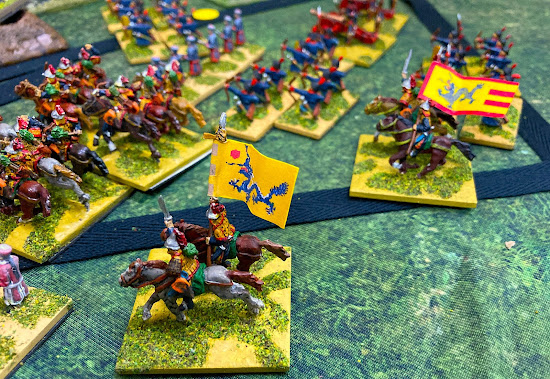A mere eight years ago, I invested in a four-volume work in Chinese: a military history of that immense yet unknown conflict, the Taiping Rebellion. (As I recorded at the time here.) Obviously I meant to generate scenarios from it, but competing priorities, lack of time, paucity of other sources, and especially the language obstacle meant this project has lain fallow ever since - until last year, when OWS made a new friend. Jeremy speaks Chinese and has studied this war seriously. He is back in Hong Kong now, has access to good Chinese sources, and has been working on BBB scenarios for it.
I was excited to see his first one arrive on our tabletop at OWS this week. Stalwart OWS member Bob Medcraft laid it on for us. Bob's garage is full of armies of all nations and eras, so it was no great problem for him to rustle up a battle's worth of 19th-century Chinese in 15mm scale. (Actually, that's not fair - although he had enough miscellaneous Oriental troops for the core of the two armies already, he did paint up dozens of extra figures specially. Some of these were figures he and some other gamers had got Steve Barber to sculpt as private commission a while ago.)
The scenario in question was for the Second Battle of Hukou (22 December 1860). This was a tricky one for Jeremy to reconstruct as he had to interpret and reconcile conflicting sources, as well as tracking down a good map. The strategic situation is that the Taipings were trying to capture the city of Wuchang, far up the Yangtze from their capital of Nanjing. To do so, they sent four widely separated columns to converge on it. One of these, some 30,000 men under Yang Fuqing, was to capture Hukou, secure water transport there, and then reach Wuchang by river. The Qing government forces defending Hukou had about 25,000 poor infantry in a stockaded defensive line east of Hukou, backed up by 15,000 or so cavalry, plus a small garrison in the town itself and adjacent fort. The stockade line had its right resting on a river and its left against a ridge of steep hills running alongside the Yangtze.
There were five victory locations: the three stockades; Hukou itself; and the village of Sanli, halfway between them. The Taipings could earn an Objective each for Hukou and Sanli; one more for taking any two of the three stockades; and another one if they held either Hukou or Sanli and the Qings failed to evacuate at least five infantry units up the Yangtze. They needed two Objectives to earn a draw or three to win.
Here's how our game of this unusual and exotic battle went.
Reflections:
The virtues of 15mm. I know there are other players who use 15mm for BBB, but at OWS we almost always use 6mm or 10mm. It was a nice change to 'go large' and see individual soldiers more clearly. We had enough figures on the table for it to still look like a battle, not a skirmish. One minor disadvantage was that Bob's base frontages were larger than the standard BBB 1" (I guess 40mm), so initial deployments were slightly more cramped than the scenario envisaged, but otherwise it worked fine.
The exotic East. We all loved the fact that we were dipping our toes in the Yangtze and learning about the Taiping Rebellion. Fundamentally it's still just 19th-century horse and musket, of course. But Jeremy's addition of Chinese weapon types and his use of standard BBB attributes to rate the two very different armies' troops captured the different flavour of this war.
Terrain aesthetics. To capture it fully, we really needed pagodas in the town, Chinese buildings in the villages, and junks on the Yangtze. Not to mention some trees in the woods (couldn't see the trees for the woods? shouldn't it be the other way round?). Hopefully we'll be better equipped next time.
Complex situations make interesting scenarios. A simple assault on a stockade line wouldn't have been much fun. (See my essay on frontal assault games here.) The fact that we had a flank option, plus an evacuation route to threaten, gave both sides more choices to make, more scope for maneuver, and more interesting things to do.
Historical research. Huge kudos to Jeremy for his work in taking conflicting sources, making sense of them, tracking down necessary geographical and other details, and turning all this into a historically accurate and eminently playable scenario that brought some obscure and fascinating history to life for us players. This is what BBB is all about!











Jeremy is to be commended. The troops looked great and would have looked even better in terrain that did them credit.
ReplyDeleteThanks, Keraunos. I'll pass your kind words on (and make sure we do better with the terrain next time).
DeleteVery good outing! Glad to see the Taiping War getting some cover!
ReplyDeleteCheers, Konstantinos! Yes, I've long regarded it as a serious gap in my gaming. Glad to have made a start on filling it.
DeleteWill you be publishing the map and OOB for this game?
ReplyDeleteMaybe once we've done the post-playtest revisions.
DeleteNicely done! Hope you get around to publishing or making the scenarios available.
ReplyDelete